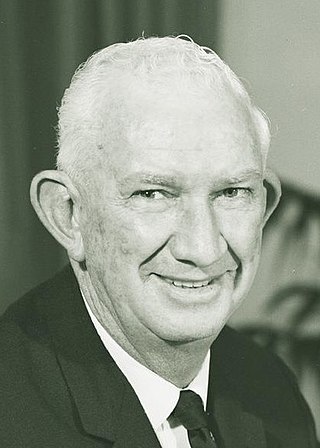
The Communist Party of Australia (CPA), known as the Australian Communist Party (ACP) from 1944 to 1951, was an Australian communist party founded in 1920. The party existed until roughly 1991, with its membership and influence having been in a steady decline since its peak in 1945. Like most communist parties in the West, the party was heavily involved in the labour movement and the trade unions. Its membership, popularity and influence grew significantly during most of the interwar period before reaching its climax in 1945, where the party achieved a membership of slightly above 22,000 members. At its peak it was the largest communist party in the Anglophone countries on a population basis, and held industrial strength greater than the parties of "India, Latin America, and most of Western Europe".

Frederick Woolnough Paterson was an Australian politician, activist, unionist and lawyer. He is the only representative of the Communist Party of Australia to be elected to an Australian parliament.

William Guy Higgs was an Australian politician who served in both the Senate and the House of Representatives. He was a Senator for Queensland from 1901 to 1906, and then represented the Division of Capricornia in the House of Representatives from 1910 to 1922. He served as Treasurer of Australia from 1915 to 1916, under Billy Hughes.

Jack Charles Allan Pizzey was a Queensland Country Party politician. He was Premier of Queensland, in a coalition with the Liberal Party, from 17 January 1968 until his death on 31 July that year. To date, he is the most recent premier of an Australian state to die in office.

George Albert Reginald Gibbons was an Australian politician. He was an Australian Labor Party member of the Australian House of Representatives from 1929 to 1931, representing the regional New South Wales electorate of Calare.

Samuel Robert Nicholls was an Australian politician. He was an Australian Labor Party member of the Australian House of Representatives from 1917 to 1922, representing the electorate of Macquarie.

George Bertrand Edwards was an Australian politician. He was a member of the Australian House of Representatives representing the Division of South Sydney for the Free Trade Party from 1901 to 1906 and the Division of North Sydney for the Liberal Party from 1910 until his death in 1911.

Arthur Lewis was an Australian politician. Born in Melbourne, he received no formal education and was raised in an orphanage. He became a farm labourer and was secretary of the Victorian branch of the Carters and Drivers Union.

William Fyfe Finlayson was an Australian politician. He was an Australian Labor Party member of the Australian House of Representatives from 1910 to 1919 and a member of the Queensland Legislative Council from 1920 to 1922.

William Patrick Conelan was an Australian politician. He was an Australian Labor Party member of the Australian House of Representatives from 1939 to 1949, representing the electorate of Griffith.

George William Martens was an Australian politician. He was an Australian Labor Party member of the Australian House of Representatives from 1928 to 1946, representing the electorate of Herbert.

James Page was an Australian politician. He was an Australian Labor Party member of the Australian House of Representatives from 1901 until his death, representing the electorate of Maranoa.

Hugh Sinclair was an Australian politician. He was a member of the Australian House of Representatives from 1906 until 1919, representing the electorate of Moreton for the Anti-Socialist Party and its successors the Commonwealth Liberal Party and Nationalist Party.

James Garfield Bayley was an Australian politician. He was a Nationalist Party member of the Australian House of Representatives from 1917 to 1931 and a Country and Progressive National Party member of the Queensland Legislative Assembly from 1933 to 1935.

John Archibald McCallum was an Australian school teacher and politician, Senator for New South Wales.
The Australian Labor Party split of 1955 was a split within the Australian Labor Party along ethnocultural lines and about the position towards communism. Key players in the split were the federal opposition leader H. V. "Doc" Evatt and B. A. Santamaria, the dominant force behind the "Catholic Social Studies Movement" or "the Movement".
Socialism in Australia dates back at least as far as the late-19th century. Notions of socialism in Australia have taken many different forms including utopian nationalism in the style of Edward Bellamy, the democratic socialist reformist electoral project of the early Australian Labor Party (ALP), and the revolutionary Marxism of parties such as the Communist Party of Australia.

Tribune was the official newspaper of the Communist Party of Australia. It was published by the Central Committee of the Communist Party of Australia from 1939 to 1991. Initially it was subtitled as Tribune: The People's Paper. It was also published as the Qld Guardian, Guardian (Melbourne), Forward (Sydney). It had previously been published as The Australian Communist, (1920-1921) The Communist, (1921-1923) and the Workers' Weekly (1923-1939).
The Building Workers' Industrial Union of Australia was an Australian trade union covering workers in the construction industry.
Gladys Dorothy O’Shane was an Australian Aboriginal activist, the sixth child of parents Caroline, née Brown, and Edgar Davis, a labourer, at Mossman, Queensland.
















